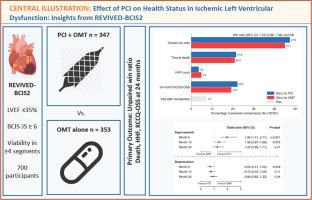当前位置:
X-MOL 学术
›
JACC Heart Fail.
›
论文详情
Our official English website, www.x-mol.net, welcomes your feedback! (Note: you will need to create a separate account there.)
Effect of PCI on Health Status in Ischemic Left Ventricular Dysfunction: Insights From REVIVED-BCIS2
JACC: Heart Failure ( IF 13.0 ) Pub Date : 2024-04-08 , DOI: 10.1016/j.jchf.2024.03.010 Matthew Ryan , Dylan Taylor , Matthew Dodd , John A. Spertus , Mikhail N. Kosiborod , Aadil Shaukat , Kieran F. Docherty , Tim Clayton , Divaka Perera , Mark C. Petrie
JACC: Heart Failure ( IF 13.0 ) Pub Date : 2024-04-08 , DOI: 10.1016/j.jchf.2024.03.010 Matthew Ryan , Dylan Taylor , Matthew Dodd , John A. Spertus , Mikhail N. Kosiborod , Aadil Shaukat , Kieran F. Docherty , Tim Clayton , Divaka Perera , Mark C. Petrie

|
In the REVIVED-BCIS2 (Revascularization for Ischemic Ventricular Dysfunction) trial, percutaneous coronary intervention (PCI) did not reduce the incidence of death or hospitalization for heart failure (HHF). This prespecified secondary analysis investigated the effect of PCI on health status measured with the Kansas City Cardiomyopathy Questionnaire (KCCQ) combined with the primary outcome in a win ratio. Participants with severe ischemic left ventricular dysfunction were randomized to either PCI in addition to optimal medical therapy (OMT) (PCI) or OMT alone (OMT). The primary outcome was a hierarchical composite of all-cause death, HHF, and KCCQ–Overall Summary Score (OSS) at 24 months analyzed using the unmatched win ratio. The key secondary endpoint was a KCCQ-OSS responder analysis. A total of 347 participants were randomized to PCI and 353 to OMT. Median age was 70.0 years (Q1-Q3: 63.3-76.1 years). Mean left ventricular ejection fraction was 27.0 ± 6.7%. PCI did not improve the primary endpoint (win ratio for PCI vs OMT: 1.05; 95% CI: 0.88-1.26; 0.58). PCI resulted in more KCCQ-OSS responders than OMT at 6 months (55.7% vs 41.0%; OR: 1.96; 95% CI: 1.41-2.71; 0.001) and fewer deteriorators (23.9% vs 31.2%; OR: 0.69; 95% CI: 0.47-1.00; 0.048). PCI did not impact KCCQ-OSS responders or deteriorators at 12 or 24 months. PCI did not improve the hierarchical composite of death, HHF, and health status at 2 years. PCI improved KCCQ-OSS at 6 months, but this benefit was not sustained to 1- or 2-year follow-up. (Study of Efficacy and Safety of Percutaneous Coronary Intervention Coronary Intervention to Improve Survival in Heart Failure [REVIVED-BCIS2]; )
中文翻译:

PCI 对缺血性左心室功能障碍健康状况的影响:来自 REVIVED-BCIS2 的见解
在 REVIVED-BCIS2(缺血性心室功能障碍血运重建)试验中,经皮冠状动脉介入治疗 (PCI) 并未降低因心力衰竭 (HHF) 死亡或住院的发生率。这项预先指定的二次分析调查了 PCI 对通过堪萨斯城心肌病问卷 (KCCQ) 测量的健康状况的影响,并结合胜率的主要结果。患有严重缺血性左心室功能障碍的参与者被随机分配接受 PCI 加最佳药物治疗 (OMT) (PCI) 或单独接受 OMT (OMT)。主要结局是使用无与伦比的胜率进行分析的 24 个月时的全因死亡、HHF 和 KCCQ 总体总结评分 (OSS) 的分层组合。关键的次要终点是 KCCQ-OSS 应答者分析。共有 347 名参与者被随机分配接受 PCI,353 名参与者被随机分配接受 OMT。中位年龄为 70.0 岁(第一季度至第三季度:63.3-76.1 岁)。平均左心室射血分数为 27.0 ± 6.7%。 PCI 没有改善主要终点(PCI 与 OMT 的胜率:1.05;95% CI:0.88-1.26;0.58)。 6 个月时 PCI 导致 KCCQ-OSS 应答者多于 OMT(55.7% vs 41.0%;OR:1.96;95% CI:1.41-2.71;0.001),恶化者较少(23.9% vs 31.2%;OR:0.69;95%)置信区间:0.47-1.00;0.048)。 PCI 在 12 或 24 个月时没有影响 KCCQ-OSS 反应者或恶化者。 PCI 并没有改善 2 年时死亡、HHF 和健康状况的分层组合。 PCI 在 6 个月时改善了 KCCQ-OSS,但这种益处并未持续到 1 或 2 年的随访中。 (经皮冠状动脉介入治疗改善心力衰竭患者生存率的有效性和安全性研究[REVIVED-BCIS2];)
更新日期:2024-04-08
中文翻译:

PCI 对缺血性左心室功能障碍健康状况的影响:来自 REVIVED-BCIS2 的见解
在 REVIVED-BCIS2(缺血性心室功能障碍血运重建)试验中,经皮冠状动脉介入治疗 (PCI) 并未降低因心力衰竭 (HHF) 死亡或住院的发生率。这项预先指定的二次分析调查了 PCI 对通过堪萨斯城心肌病问卷 (KCCQ) 测量的健康状况的影响,并结合胜率的主要结果。患有严重缺血性左心室功能障碍的参与者被随机分配接受 PCI 加最佳药物治疗 (OMT) (PCI) 或单独接受 OMT (OMT)。主要结局是使用无与伦比的胜率进行分析的 24 个月时的全因死亡、HHF 和 KCCQ 总体总结评分 (OSS) 的分层组合。关键的次要终点是 KCCQ-OSS 应答者分析。共有 347 名参与者被随机分配接受 PCI,353 名参与者被随机分配接受 OMT。中位年龄为 70.0 岁(第一季度至第三季度:63.3-76.1 岁)。平均左心室射血分数为 27.0 ± 6.7%。 PCI 没有改善主要终点(PCI 与 OMT 的胜率:1.05;95% CI:0.88-1.26;0.58)。 6 个月时 PCI 导致 KCCQ-OSS 应答者多于 OMT(55.7% vs 41.0%;OR:1.96;95% CI:1.41-2.71;0.001),恶化者较少(23.9% vs 31.2%;OR:0.69;95%)置信区间:0.47-1.00;0.048)。 PCI 在 12 或 24 个月时没有影响 KCCQ-OSS 反应者或恶化者。 PCI 并没有改善 2 年时死亡、HHF 和健康状况的分层组合。 PCI 在 6 个月时改善了 KCCQ-OSS,但这种益处并未持续到 1 或 2 年的随访中。 (经皮冠状动脉介入治疗改善心力衰竭患者生存率的有效性和安全性研究[REVIVED-BCIS2];)



























 京公网安备 11010802027423号
京公网安备 11010802027423号